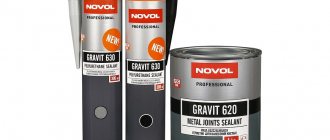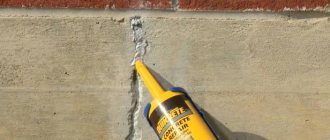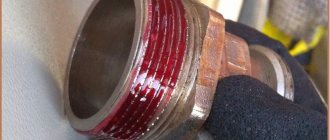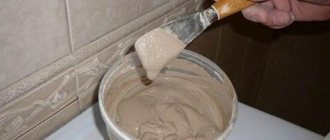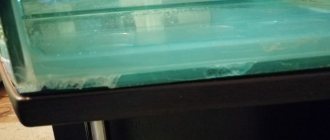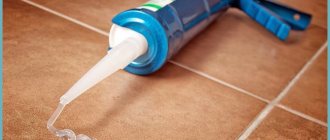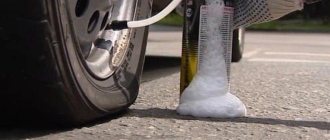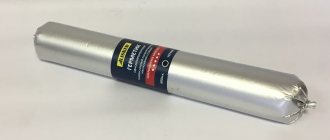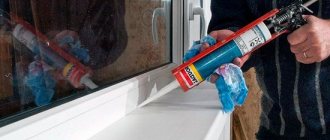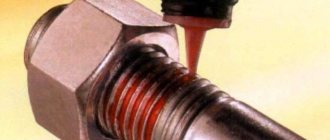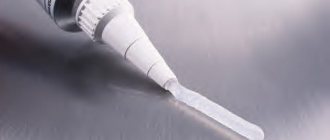TOP 10 best sealants for car seams
The main function of seam sealant for a car is to protect the surface of the weld from contact with the external environment. This makes the seam stronger and also minimizes the risk of corrosion (rust forms when metal comes into contact with water or air particles). Sealant in a car can be used to seal cracks, scratches, and small holes.
Sealants differ in composition, method of application, and technical characteristics. The most popular in the Russian Federation are compositions. Novol Gravit 630, Reoflex Brush Sealant, Body 999, Merbenit XS55 and others. Let's look at the TOP 10 best sealants and look at their pros and cons.
Novol Gravit 630
Polyurethane based sealant. Available in tubes for automatic pistols. Seals large and small holes well and does not crack due to deformation or vibration in the car. Before application, it is recommended to clean, degrease and coat the surface with a layer of primer. After application, the composition dries within 20-30 hours .
The average cost is 350 rubles per 300 ml tube.
Advantages:
- Good technical properties;
- Ease of use;
- Low price;
- Wide availability;
Flaws:
- Takes a long time to dry;
- Preliminary surface preparation is required.
Reoflex Brush Sealant
Another good polyurethane-based mixture. Sold in cans for brush application. Protects the weld area from debris, corrosion, and chemically active environments. Tolerates short-term temperature changes, vibration and mechanical deformation. Before application, the surface should be cleaned and degreased; application of a primer is also recommended. Hardens within 20-30 hours .
Price – 600 rubles per 800 ml jar.
Advantages:
- Good adhesion to the surface when applied.
- Good technical properties.
- Reasonable price, large volume.
Minuses:
- Takes a long time to dry;
- Before application, the surface must be cleaned and primed.
Body 999
The composition is made on the basis of rubber and synthetic resins. Sold in large banks. Suitable for protecting automotive seams, as well as for gluing damaged parts, sealing cracks and holes. Easily withstands mechanical shocks, temperature changes, and exposure to non-aggressive chemicals. It does not tolerate exposure to direct sunlight, so it should be used in closed areas of the body and spare parts.
Price – 500 rubles per 1 liter jar.
Pros:
- Good technical performance.
- Can be used for gluing damaged body parts.
- Low price, easy application.
A major drawback is that it can only be applied to closed surfaces.
Merbenit XS55
Made on a silane-modified base, sold in small tubes. Easy to apply to the work surface and dries quickly. Easily withstands exposure to ultraviolet radiation, chemicals, mechanical shock, and vibration. Retains strength in severe frosts and heat. The average cost is 850 rubles per 300 ml tube.
Pros:
- Excellent adhesion to the surface;
- Easily copes with temperature changes;
- Hardens quickly after application.
The disadvantage is the very high price.
APP PU-50
A cheap polyurethane composition produced in cartridges for spraying using guns. It has average technical characteristics. But it is resistant to vibration and mechanical shock, and withstands the effects of chemically active substances well.
Price – 250 rubles per 300 ml tube.
Pros:
- Low price;
- Ease of use;
- Not a bad level of protection.
Minuses:
- Cracks in severe frosts;
- It hardens for a long time.
ZM 08537
Universal type silicone sealant. It can be used not only for sealing seams, but also for gluing damaged fragments, sealing cracks and holes. Hardens in 15-20 hours, easy to paint and varnish. Available in the form of a sticky liquid poured into jars.
Cost – 2000 rubles per 1 liter jar.
Pros:
- Good technical performance;
- Dries quickly;
- Can be painted, varnished;
Cons: high price.
Teroson Terostat 9320
Another polyurethane sealant designed to be sprayed with a gun. Contains additives that accelerate drying of the composition (approximate hardening time is 12-18 hours). Resistant to ultraviolet radiation, chemically active substances, corrosion, and strong vibrations. Recommended for use on primed surfaces.
Price – from 1000 rubles per 300 ml tube.
Advantages:
- Good technical characteristics;
- Convenient use (gun).;
- Accessibility, online availability.
Disadvantages - high price, there are fakes.
Boll
A polyurethane mixture containing a number of useful additives is available in the form of tubes for spraying with a gun. It dries quickly, adheres to any surface, and can be used to seal weld seams, eliminate small cuts and cracks. Retains technical properties in frost. It is advisable to varnish before application.
Price – 700 rubles per 300 ml tube.
Advantages:
- Good adhesion to the surface;
- Hardens quickly;
- Convenient use.
Minuses:
- Rarely sold in stores;
- High price.
Crocodile
Inexpensive but high-quality polyurethane-based sealant. Available in the form of tubes for automatic pistols. It is distinguished by high levels of strength, adhesion, and reliability. It withstands precipitation, vibration, and thermal effects well. It is recommended to apply over a layer of primer.
Price – 300 rubles per 300 ml tube.
Advantages:
- Low cost;
- Good technical performance;
- Fast hardening;
Minuses:
- May crack in severe frosts;
- There are many fakes on sale;
APP Butyltape
It is a tape, on one side of which an adhesive sealing composition based on rubber with additives is applied. The tape is usually used to repair minor scratches and imperfections on the body. Can be used for sealing seams. This minimizes the risk of corrosion and protects against ultraviolet radiation and chemically active substances.
Price – 2000 rubles (width 20 mm, length 26 m).
Pros:
- Convenient use;
- Very fast hardening;
- Good technical properties.
Disadvantage : high price, not suitable for sealing large welds.
Advantages and disadvantages of anaerobic composition for engine repair
When repairing an engine using automotive sealant, the following advantages are highlighted:
- The flexibility of the seam has a positive effect on the quality and reliability of the connection.
- The presence of oxygen leaves it in a soft state, which allows assembly and adjustment to be carried out slowly.
- Provides adhesion when there is a lack of air.
- A reliable, homogeneous shell is formed on the motor elements.
- High temperature.
Flaws:
- With a thick layer, it is difficult to block the complete access of oxygen, so its thickness does not exceed 0.5 mm.
- Increased pressure on the connection will lead to its destruction.
- Careful, even application is required. Since air will leak onto the uneven part, and the sealant will remain in its original condition.
- Before application, the surface must be completely cleaned, otherwise the ingress of debris will lead to partial sealing.
- For the engine sump, application is carried out immediately before assembly.
Types of joint sealants by composition
Joint sealants are made on the basis of various components - acrylic, bitumen, silicone, polyurethane mixtures. A special position is occupied by anaerobic compounds, which are very different from other sealants in composition and physical properties. Below each category a brief description will be given.
Acrylic
The composition is made on the basis of thick liquid polymethyl methacrylate. Acrylic sealant easily adheres to the metal surface, has high strength, but has mediocre elasticity. Therefore, in the case of high loads or strong vibrations, the stuck mixture may peel or delaminate. Therefore, acrylic should only be used to seal seams in stable areas of the vehicle. Acrylic has good contact with paint or paint, so it can be painted or varnished.
Pros:
- Ease of use;
- Good adhesion, strength;
- Friendly with brief and varnish;
- Low cost.
Minuses:
- May peel off under heavy loads.
Bituminous
The sealant is made on the basis of bitumen and is a thick sticky paste of black or dark gray color. Bitumen compositions have good adhesion, strength, elasticity, and do not come into contact with chemically active substances. Before application, the surface must be cleaned of debris and dust (otherwise, tightness is not guaranteed). Can be applied to any smooth surface.
Pros:
- Good technical performance;
- Effectively protects against moisture and chemicals;
- Easy to apply, dries quickly;
Minuses:
- Before use, clean the surface;
- Does not lend itself well to painting or varnishing.
Silicone
They are made on a silicone basis, and the consistency resembles a thick paste. When applied, it quickly hardens, creating a durable protective layer of silicone on the surface of the seam. Can be applied at sub-zero temperatures. Easy to paint and varnish. Good adhesion, strength, durability. The main disadvantage is that they are poorly suited for sealing small grooves (due to the large size of the fractions).
Pros:
- Good technical properties;
- Low price, sold in any stores and online;
- Can be used in cold weather;
Minuses:
- Not suitable for sealing small seams and surface defects.
Anaerobic
Made on the basis of acrylic monomers and oligomers with the addition of additive components. Made in the form of a liquid that hardens when applied. Recommended for filling small seams, cracks and grooves. When applied to large areas, anaerobic sealants do not harden. They have very high strength, but mediocre elasticity (they can crack under strong shaking).
Pros:
- They perform well when working with small seams;
- High strength, good protective properties.
Minuses:
- Not suitable for working with large areas;
- May crack under strong vibrations.
Polyurethane body sealants
They are made on the basis of polyurethane components, which quickly harden when the substance is applied to the surface of the seam. They are characterized by high strength, elasticity, and durability. Under heavy loads, they retain their shape, do not crack or peel off . Withstands high and low temperatures (can be applied in frost or extreme heat). Before application, the surface must be coated with a primer to improve adhesion.
Pros:
- Wide temperature range;
- Retains shape during vibration and shock.
Minuses:
- Apply only to primed surfaces.
What types of car seam sealants are there based on application method?
Seam sealant for cars is applied in three ways - with a brush, tape, using a tube (manually or with a gun). Each method has its own characteristics, and some categories of sealants have restrictions on the method of application. Each method will be briefly discussed below.
Brush
Such sealants are produced in the form of a thick liquid, and they are sold in metal or plastic containers with a lid of 200, 500 or 1000 milliliters. To use the composition, you need to carefully remove the lid, dip the brush in the liquid and apply it to the welding seam. It is recommended to carry out application work with gloves. The drying time for such compositions is up to 12 hours or more.
Any small width brush with a plastic or wooden handle can serve as a brush. Upon completion of application, the jar should be closed with a lid and placed in a cool, dry place for storage. Canned sealants for brush application typically have a shelf life of 1 year from the date of opening, but no more than 3 years from the date of manufacture . There are also more durable formulations - see the exact date of manufacture on the packaging.
Advantages of the method:
- Sold in containers of different sizes;
- Easy to apply to the weld;
- Can be stored for a long time;
- Convenient for workshops.
Flaws:
- Apply for a long time to the seam surface;
- The method is not suitable for applying paste.
Attention! If the date of manufacture is not indicated on the jar or it is covered up, then there is a high risk that the shelf life of the composition has expired. Or you bought a counterfeit.
Ribbon
It looks like a long tape, on one side of which a sealing compound is applied. To apply it, it is glued on top of the seam along the entire length, and after 1-2 hours it completely hardens and sets. The working surface is usually impregnated with bitumen sealant, although acrylic and silicone-based tapes are also available. There are also double-sided tapes, where an adhesive composition is applied to the second side (in practice, the need for double-sided tape is rarely necessary).
Most tapes are small in width (up to several centimeters). Therefore, this method is not suitable for sealing wide seams, as well as when working with seams of complex shape (roundings, bends). If you are dealing with a non-standard and/or wide seam, it is better to apply it with a brush or an air gun. Benefits of using tape:
- Very convenient application;
- Fast hardening;
- Low price;
- Easy to transport.
Minuses:
- A small variety of sealing compounds;
- Not suitable for sealing complex or wide joints.
Sealants for cars in tubes (squeezable)
Extruded sealants come in two categories:
- Tube containers. These tubes are compact in size. To use, you need to manually dispense the paste from the tube onto the working tool and apply it to the work surface. Paste-like sealants (acrylic, silicone, bitumen) are usually sold in tubes. Tubes are well suited for sealing small seams, while processing large seams with them is inconvenient and time-consuming. The main advantages are low cost, ease of use, large selection. Disadvantages - not suitable for working with large areas, limited shelf life after opening.
- Containers for a pistol. Such containers are made in the form of a narrow cylinder with a long spout at the end. For use, the container is inserted into a mechanical or pneumatic gun. Now the sealant can be applied using a gun to the seam (the gun itself will squeeze out the compound). Using the gun is very convenient, and with its help you can quickly and conveniently process any area. The main advantages are very convenient use, good selection, large capacity. No significant deficiencies were found.
We continue the series of articles for beginning craftsmen. In the second issue we will talk about anaerobic compactors. They are the pinnacle of the evolution of sealing materials. To immediately dispel doubts about their effectiveness, let's play trump cards. Developed in the 50s in the USA, anaerobic seals have been used for almost half a century to lock fasteners in aviation and space technology. And only recently have they migrated to the domestic sphere. If they are trusted with such critical systems, then the assembly of the home water supply system, the installation of the collector and the connection of the washing machine can definitely be trusted.
Anaerobic compactors - what they are and how they work
You need to know at least in general terms what you use to repair your home. Therefore, without going into details of the chemical composition, we will tell you how anaerobic sealants work.
The name “anaerobic” means that the main condition for this type of sealant to work is the absence of oxygen. When it gets into the gap between two parts when assembling a joint, some components enter into a process with oxygen and completely consume it. An oxygen-free environment is created inside, which allows the viscous gel to harden, or, more precisely, to harden and turn into a heavy-duty polymer.
That is why inside the tube and when applying the gel, i.e. in an oxygen environment, it has a gel-like form, and when twisted it becomes solid.
The gel sets only upon contact with metal. It does not have adhesion to plastic, so it is used only for sealing metal joints. It is important. Only in this case can the tightness of the connection and the safety of the system be achieved. We, as manufacturers, are familiar with the practice of sealing plastic threads. But it is not in our area of responsibility and contradicts the recommendations and official instructions for the use of anaerobic compactors.
Scope of application
Where to use anaerobic sealants in the home? Almost anywhere you need to seal a threaded metal connection: for assembling a water supply system, a drinking pipeline, a heating and gas supply system. In this case, the coolant temperature should not exceed 150 °C.
We advise home craftsmen to seal joints with anaerobic gels in accessible places - where there will be no problems with disassembling and replacing parts if necessary. And for non-professional work, do-it-yourself work, purchase Green quick-disassembling SantekhMaster Gel.
Product overview
SantekhMaster Gel is the first plumbing anaerobic sealant to appear in Russia. Available in the form of a green, blue and red gel in a tube with a flat neck. The speed of its polymerization depends on the color of the sealant, i.e. hardening inside the joint, and the force during dismantling.
Green SantekhMaster Gel is designed for easy dismantling. You can untwist the connection with it almost effortlessly. Suitable for pipes up to 1.5 inches in diameter. Polymerization time is 20-30 minutes. This means that after twisting and tightening the connection, you need to wait about half an hour to test run the system. The easiest to use and versatile anaerobic sealant. The best choice for home projects.
Blue SantekhMaster Gel with a medium degree of fixation will require effort during dismantling and it will take some time. 2-3 minutes. Suitable for sealing threaded connections on pipes up to 2 inches in diameter. Waiting time is 10-15 minutes. Those. this composition hardens faster.
And finally, SantekhMaster Red Gel for cast iron and steel. Powerful anaerobic sealant for ferrous metals. To unwind it will most likely require heating with a heating pad or an industrial hair dryer. It’s unlikely that your family really needs this tool, so leave the red tube to the professionals. When heated, it unwinds quite quickly. Used to connect pipes with a diameter of 1/2 inch. Polymerization time is only 5 minutes.
When professionals talk about anaerobic sealants - especially those who are accustomed to sealing with flax - their main argument in the dispute concerns precisely the difficulty of dismantling. But in reality there are no problems. A professional will unwind even the most stable connection in just a couple of minutes. Preheating it. A beginner, who is also a home craftsman, will cope with this task just as quickly and without outside help. Because he will choose a lightweight composition that combines two main advantages - absolute tightness and ease of promotion. Remember, this is green sealant.
Characteristics of anaerobic compactors
- Easy to apply
- Does not require additional materials, completely ready for use
- Protects threads from corrosion
- Versatile
- Not afraid of water hammer and temperature changes
- Have high chemical resistance
- Allows adjustment after assembling the connection - the connection can be slightly unscrewed or tightened until the gel has dried
- Allows you to make a neat, beautiful connection
- Non-toxic, not harmful to skin
- If it gets on a surface near the parts being sealed (on the floor, on a hand, on any part), it does not corrode it and is quickly removed with a napkin or rag.
How to apply
We know that it is important for any non-professional to keep it simple and understandable. I bought it, I read it, I did it. Without complications and wasting time, without searching for additional information. SantekhMaster Gel is available in a package with instructions that detail how to apply the gel correctly and how long to wait. In the package you will find a special brush, with the help of which the gel is distributed evenly over the thread, and the remainder - if there is any - is transferred to the next one. It's more economical.
It turns out that by purchasing a package of gel, you get a full-fledged sealing tool.
- The gel is applied to a new, clean thread immediately, without preparation.
- They do this directly from the tube, carefully squeezing the gel onto the thread.
- Move the neck along the perimeter of the thread, the gel will envelop each turn.
- Prepare the brush in advance; you will use it to remove excess gel after assembling the joint and transfer it to the next thread.
- Assemble the connection and wait the time indicated on the package.
- Check the tightness by test running the system.
The assembly time (even for the first time) of one connection on Green SantekhMaster Gel is no more than 1 minute. For comparison, compacting with flax even by a professional takes about 6 minutes. The flax must be measured and cut, applied correctly, spread paste on top, assemble the joint, remove protruding threads and clean it. No “I came, I saw, I conquered.”
If the thread is old or dirty, it must be degreased and cleaned. Available means are suitable for this: alcohol or vodka. If any of this is in the house, other solvents are not needed. After degreasing, the gel sealant is applied as described above. There are no differences.
Let's summarize the advantages of anaerobic sealants for beginners
- Convenient packaging: instructions, brush included
- Convenient release form: gel consistency does not spread; It is easy to distinguish the area of application of the sealant by color (Green, Blue and Red)
- Economical consumption - one tube will last for a long time. A 15 g tube can hold up to 40 fittings, a 60 g tube can hold up to 150.
- Easy application - you can immediately seal threads without training, just read the instructions.
- The connection is clean and neat - which is important for assembly in accessible, open areas
With the help of anaerobic sealants, you can solve not only the problems of assembling plumbing, heating and gas systems, but also carry out minor household repairs. Waterproof a flashlight, fix a 3D printer, seal threads on a bicycle, and repair a pump. Among all the advantages of anaerobic gel sealants, versatility is the most useful and necessary for home craftsmen.
How to remove old sealant
If you applied a sealing compound and it cracked, you need to select another sealant and reapply it. Before resealing, it is necessary to remove the old compound from the surface of the car. Usually old sealant is very fragile, and to remove it you just need to pry it with your finger or any other tool. If part of the old composition cannot be removed manually, you can try the following methods:
- Warm up with a hairdryer. Many powdered sealants become soft when heated, and can be removed using a handy tool. The heating time of the hairdryer depends on the power of the device and the composition of the sealant. Usually 3-5 minutes are enough to heat up.
- Use white spirit. This liquid is a universal solvent. FOR application, soak cotton wool with a small portion of white spirit, and treat the surface of the old sealant with the cotton wool. Repeat the operation 2-3 times, wait a few minutes, remove the remnants of the old composition manually or using tools.
- Use acetone. White spirit is a good solvent, but some categories of sealants do not respond well to it. If this is the case, then you should treat the old composition with acetone. It is applied in the standard way - saturate the cotton wool, wipe the surface, repeat the procedure, wait 3-5 minutes.
Attention! If, when applying new sealant, some of it gets into the wrong place, then immediately remove it with a rag or cotton wool. The sealing compound does not harden immediately, so there is no need to use a hair dryer, white spirit or acetone.
Dismantling threaded connections with anaerobic sealant
Depending on the strength of the glue used, the process of dismantling the joints also varies.
Connections that are made using a low-strength compound can be disassembled manually without much effort. Medium strength sealants provide a more secure hold, so removal will require a special tool.
The greatest difficulty is dismantling joints that are connected using a high-strength compound. To begin with, the thread is heated at temperatures from +230 to +250 °C for 5-10 minutes. After thermal exposure, the thread is unscrewed using special tools, and the remaining adhesive is removed with a wire brush.
How to choose sealant for car seams
- If you can’t decide on a choice, buy polyurethane sealant in a tube for filling into a gun . Such sealants have a well-balanced composition, do not deteriorate during storage, and are easy to apply to the surface. In addition, they are often found on sale, so there should be no problems with purchasing.
- Acrylic compounds have a low price , but it is recommended to use them only for sealing small seams. In all technical indicators, acrylic is inferior to bitumen, silicone and polyurethane, and such mixtures are not much more expensive. In addition, acrylic often cracks during use, so you will have to constantly patch the seams.
- There is no need to be afraid of automatic pistols. Many novice mechanics prefer to take liquid sealant or mixtures in tubes, because they are afraid of pistol spraying. But this is the wrong approach: it is very easy to handle the gun - just do a couple of test sprays.
Types and scope of application
The higher the number, the stronger the connection
. Thread sealant is classified according to the strength of the resulting connection . There are 3 classes.
- Low strength - withstands a load of 0.5–6 MPa. Designed for gluing threads that often have to be disassembled.
- Average strength – 6–12 MPa . It is used to seal connections that are disassembled only during repairs or during service work. Usually these are parts of engines, presses, and threaded connections of gearboxes.
- Increased strength - withstands more than 12 MPa . Connections are dismantled only in extreme cases, so this composition is extremely resistant to mechanical damage and temperature changes. This is usually a heat-resistant composition.
They produce one- and two-component mixtures. In everyday life they prefer the former. In industry, multicomponent compositions are used.
The scope of application of anaerobic sealants is huge:
- locking and insulation of threaded and flanged connections of any type;
- sealing of welds, metallurgy products, porous sheets;
- sealing pipe threads, flange connections;
- fixation of cylindrical elements.
In everyday life, anaerobic sealants are most often used to seal joints in plumbing and heating systems.
How to apply sealant
The method of applying the sealant depends on its composition, consistency and release form. In practice, a silicone compound is used to seal seams, and it is sprayed using a gun. Let's consider a brief application algorithm for this case:
- The surface to be treated is cleaned of debris and dust. If necessary, degreasing and drying is performed. At the end, a layer of primer is applied, and the master should wait for it to dry completely.
- The tube is inserted into the gun and the quality of the connection is checked. After this, a thin layer of the composition is sprayed in the desired area. Its excess is removed using gauze or cotton wool.
- Most sealing mixtures harden within 24 hours. After this time, painting or varnishing can be done.
Review of common sealants
The following motor sealants are well proven and widely used:
- Loctite 574 anaerobic flange sealant is produced by Henkel. Highly effective product. Suitable for repairing the engine oil system. The permissible norm for the best hardening and the formation of a flexible, reliable seam is from 15 to 25 degrees. Used between metal surfaces where there is a complete absence of air. It is used as a sealant for closely adjacent planes with the smallest opening.
- Valve cover agent – ABRO 11-AB . Withstands elevation up to 343 degrees, oil resistant, withstands machine influences. It is comfortable to use, as it has a special spout that allows you to apply a thin layer. It is used for valve cover gaskets, as it does not lose its properties when used in difficult circumstances.
- Anaerobic preparation, motor-hull photo-padding acryplast K161 . Excellent composition for tight slates, perfect insulation for small holes. Withstands high pressure. Resistant to chemicals. After drying, it acquires significant rigidity, therefore it is suitable for connections where rigid gaskets are used.
- The range of engine anaerobes FÖRCH K157, K158 and K161 have excellent data. Withstands high temperatures and pressure, with super-extreme engine loads. Suitable for repairing motor flanges and threaded connections. When dry, it provides a flexible seam with increased adhesion, durable insulation, and resistance to chemicals. For complete hardening, it is necessary to provide a significant temperature from 80 to 100 degrees. Use according to instructions. Do not use as a replacement for gasket material between the cylinder head and cylinder block.
- Engine sump sealant – Dow Corning Q3-1566 . Heat-stable, oil-resistant, resistant to cooling liquids.
